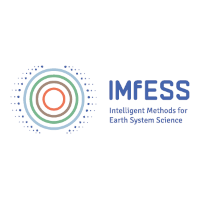Participating working groups - Geophysics and Meteorology
This page lists all working groups of the Institute for Geophysics and Meteorology those research focuses fit the ideas of the key profile area "Intelligent Methods for Earth System Sciences".
The research group RG Tezkan focuses on Applied Geophysics. This field of work utilises geophysical measurement methods in order to find mineral deposits of resources such as oil, gas, or metal ore, in the upper 10 km of the Earth's crust. The increasingly important applications in environmental geophysics also belong to the applied geophysics. They explore the uppermost 1000 m, for example, in the context of disposal and contaminated sites or ground water. The last group belonging to the applied geophysics are the engineer geophysics, which play an important role in the preparation of large building measures.
The research group RG Saur is focused on "space physics". Space Physics encompass the physics of the (Earth-near) open space, mainly the magnetosphere and solar wind. In a wider sense they include the application of knowledge obtained on the system Earth to other planets and moons, for example the investigation of the interactions between the magnetosphere of Saturn and the moon Titan. Main topics of the research group of Prof. Joachim Saur are magnetic fields and plasma.
The research group RG Shao focuses on the modeling and parameterization of the dynamic processes, which are responsible for the interactions between the various components of the climate system. The use of integrated modeling systems enables the embedding of expert knowledge of various other sciences.
The RG Crewell is focused on different topics of meteorology. An example: The Arctic is experiencing rapid changes which result from complex feedback mechanisms which are not well understood. A better understanding of the Arctic climate system is thus a key challenge which we address by exploiting ground-based and satellite remote sensing observations. In particular, we want to gain insight into water vapor, clouds, precipitation and radiative effects in the Arctic. Detailed observations are crucial here and available from long-term measurements at Ny-Ålesund but also from campaign based activities, e.g. MOSAiC.
The RG Vercauteren aims to advance the modelling and parameterization of dynamical processes in meteorology, particularly by exploiting the optimal fusion of extensive observational datasets with computational modelling. They have a particular interest in processes occurring in the atmospheric boundary layer and how those affect the weather and climate system. This includes studying energy and mass exchange processes across scales in the atmosphere, as well as understanding near-surface dynamical processes. They also study how the atmosphere organizes in different flow regimes with distinct dynamical characteristics, what leads to regime transitions, and how different flow regimes impact exchange processes.
The RG Löhnert is focused on exploiting observations in meteorology: There are much too few observations in the lowest 1-2 km of the atmosphere, the so-called atmospheric boundary layer (ABL). We perform research on new meteorological observation systems and investigate if and how these can improve our knowledge on the structure of the ABL, e.g. temperature, humidity and winds. Developing such methods can help us shed light on the physical processes in the ABL such as turbulent fluxes or cloud and precipitation formation. Also, we investigate the impact of these observational methods on short-term weather forecasts and high-resolution re-analyses.
The research group for Integrated Scale-Adaptive Parameterization and Evaluation (InScAPE) RG Neggers aims to develop scale-adaptive parameterizations of small-scale turbulent/convective processes and clouds for larger-scale models, and to constrain those with relevant measurements as obtained from permanent meteorological “supersites”. In addition, we investigate the role of boundary layer clouds in a larger context, including their coupling to the Earth's surface and the role they play in global climate change.
